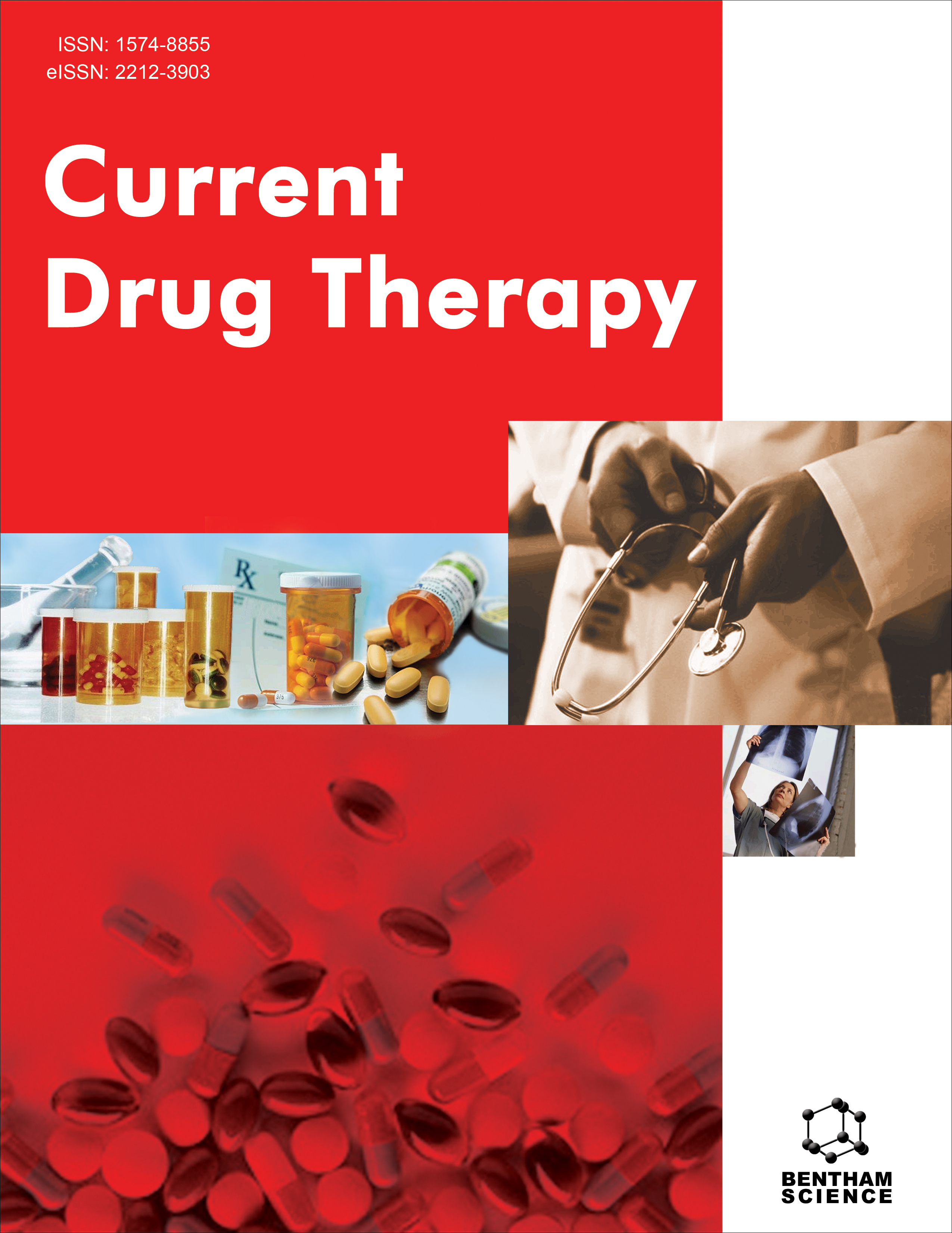- Home
- A-Z Publications
- Current Drug Therapy
- Previous Issues
- Volume 19, Issue 2, 2024
Current Drug Therapy - Volume 19, Issue 2, 2024
Volume 19, Issue 2, 2024
-
-
A Progressive Stratagem Outline on Diverse Dermatological Clays
More LessAuthors: Rashmi Pal, Yogendra Pal, Merugumolu V. Kumar, Deepti Katiyar and Saranya PunniyakottiFor a very long time, clay has been widely utilized in cosmetics, and it is still one of the most widely used components today. There is clay for every skincare issue and problem, including dryness, irritation, sunburn, and oiliness. Finding the appropriate clay for the skin's type, texture, and needs is the primary consideration. The current effort attempts to compile knowledge on the many dermatological types of clay that are naturall Read More
-
-
-
Intranasal Drug Delivery of Antiviral Agents - A Revisit and Way Forward
More LessAuthors: Jino Affrald R and Shoba NarayanEven to this date, oral drug delivery in the form of tablets, capsules, and syrups is considered as the most accepted one. However, oral delivery as a methodology requires that the active molecules and their formulations are water-soluble. Nasal drug delivery is characterized by ease of permeability through the epithelial mucosa, low enzyme activity, and a wide range of immunocompetent cells. For the transfer of drugs Read More
-
-
-
A Complete Sojorum on Thermosensitive Hydrogels for Wound Healing: Recent Developments and Ongoing Research
More LessAuthors: Tanmay S. Markandeywar, Dilpreet Singh and Raj Kumar NarangThe nature of the wound typically dictates the available wound-healing therapies. On the other hand, inadequate care results in persistent wounds, fibrosis, tissue loss of function, and ultimately dismemberment. Suturing, unloading, irrigation, debridement, negative pressure therapies, growth factor supplementation, and grafting are examples of current medicines that all have limitations in terms of meeting the needs of full tr Read More
-
-
-
Therapeutic Repurposing of Antidiabetic Drugs in Diabetes-associated Comorbidities
More LessBackground: Diabetic patients suffer from various comorbidities like cardiovascular diseases (CVDs), cancer, obesity, cognitive impairment, gout, leishmaniasis, etc. Objective: We aimed to review the pathological links between diabetes and its comorbidities and discuss the justification for using antidiabetic drugs in diabetes and associated comorbidities. Methods: Diabetic patients accompanied by comorbidities had to unde Read More
-
-
-
New Insights into Microglia as Therapeutic Targets in Alzheimer’s Disease
More LessAuthors: Deepa S. Mandlik, Satish K. Mandlik and Heena B. ChoudharyAlzheimer's disease (AD) is the most common neurodegenerative disease, accounting for 60–70% of dementia cases globally. Inflammation of the central nervous system (CNS) caused by microglia is a common characteristic of neurodegenerative illnesses such as Parkinson's disease and AD. Research has recently examined the relationship between neurodegenerative diseases and CNS microglia. Microglial cells comprise 10– Read More
-
-
-
Protective Effects of Propolis on Behavioral and Stress Oxidative Changes in Cuprizone-Induced Demyelination Model
More LessObjective: Multiple sclerosis (MS) is a continuing demyelination inflammatory disease of the central nervous system (CNS). In this study, we investigated the effect of propolis on locomotor coordination and stress oxidative modifications in the demyelination model induced by cuprizone because of its antioxidant, neuroprotective, and anti-inflammatory properties. Methods: Mice were nourished with powdered chow, inclu Read More
-
-
-
Characterization and Extraction of Bioactive Compounds in Ethanolic Extract of Moringa concanensis, Nimmo Leaf, Using Microwave-assisted and Soxhlet Techniques
More LessBackground: The extraction of Moringa concanensis (Nimmo leaf) was done in ethanol using Soxhlet and microwave-assisted extraction (MAE) techniques to obtain bioactive compounds. Methods: The standard techniques were used to carry out phytochemical analysis of ethanolic extract. The analysis confirmed the presence of flavonoids, phenols, steroids, alkaloids, terpenoids, glycosides, tannins, and saponins, and also t Read More
-
-
-
Accelerating Healing of Excisional Wound with a Hydrogel Containing Hyacinth Bean (Dolichos lablab) Extract in a Rat Model
More LessAuthors: Neelam Singh, Puneet Gupta, Radha Goel, Chaitanya V. Narayan, Deepak Sagar and Aanchal GuptaIntroduction: Medicinal plants are essential in the treatment of a wide range of illnesses. Dolichos lablab, also known as Hyacinth Bean, is a popular legume crop in India that is rich in natural bioactive compounds. In recognition of its importance in many skin therapies, a hydrogel was prepared. The primary goal of topical formulations is to provide drug contact with the skin while reducing overall absorption. The aim of this study Read More
-
-
-
Quality by Design Enabled Formulation Optimization of Rabeprazole Sodium Mucoadhesive Microcapsules for the Treatment of Gastroesophageal Reflux Disease
More LessAuthors: Jayanti Panda, Suryakanta Swain and Muddana Eswara Bhanoji RaoAims: The present research describes the implementation of quality by-design principles for developing the mucoadhesive microcapsules of rabeprazole sodium for treating gastroesophageal reflux disease conditions. Background: In addition, a holistic QbD-based product development strategy was implemented, where the target product profile was defined based on desired product quality of mucoadhesive microcapsul Read More
-
-
-
Antifertile and Estrogenic Effects of Sida acuta Root on Experimental Animal Models
More LessBackground: Herbal medications have been used for centuries in traditional Indian medicine to reduce fertility in several regions. Among them, Sida acuta (S. acuta) is a traditional herb having antifertility effects with other broad medicinal properties. In this work, it was studied for its effect on fertility in female rats. Objective: The purpose of this research was to conduct effectiveness and safety investigations on S. acuta root, a Read More
-
Volumes & issues
-
Volume 20 (2025)
-
Volume 19 (2024)
-
Volume 18 (2023)
-
Volume 17 (2022)
-
Volume 16 (2021)
-
Volume 15 (2020)
-
Volume 14 (2019)
-
Volume 13 (2018)
-
Volume 12 (2017)
-
Volume 11 (2016)
-
Volume 10 (2015)
-
Volume 9 (2014)
-
Volume 8 (2013)
-
Volume 7 (2012)
-
Volume 6 (2011)
-
Volume 5 (2010)
-
Volume 4 (2009)
-
Volume 3 (2008)
-
Volume 2 (2007)
-
Volume 1 (2006)
Most Read This Month
Article
content/journals/cdth
Journal
10
5
false
en


